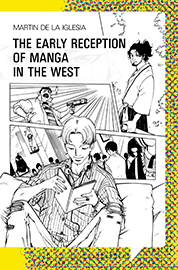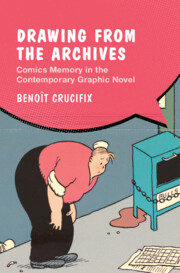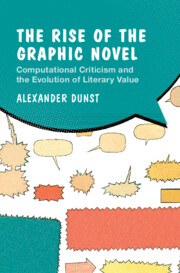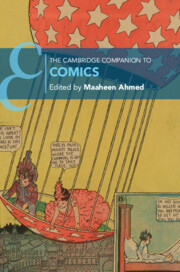Im Monitor werden in unregelmäßigen Abständen aktuelle Publikationen aus den letzten 6 Monaten vorgestellt, die für die Comicforschung relevant sein könnten. Die kurzen Ankündigungstexte dazu stammen von den jeweiligen Verlagsseiten. Haben Sie Anregungen oder Hinweise auf Neuerscheinungen, die übersehen worden sind und hier erwähnt werden sollten? Das Team freut sich über eine Mail an redaktion@comicgesellschaft.de.
→ Zu früheren Monitoren.
 Disability and the Superhero: Essays on Ableism and Representation in Comic Media
Disability and the Superhero: Essays on Ableism and Representation in Comic Media
Amber E. George (Hg.)
Ch. A. Bachmann Verlag
Juni 2023
Verlagsseite
„This is a collection of essays that analyze the presence of ableism in superhero narratives from television shows, films, and comics. Contributors use critical disability studies, media studies, cultural studies, and other interdisciplinary fields to unveil the misinformation, stigma, and exclusion caused by ableist representations of disability or disability-related experiences. Ableism is unmasked in media franchises such as DC Comics, Marvel, Sesame Street, and more.
These essays go beyond what is currently available in critical disability superhero studies, and explore both the well-known and lesser-known characters including Iron Man, Daredevil, Dr. Strange, Thor, Nick Fury, Jessica Jones, War Machine, Wonder Woman, Dr. Poison, the Joker, Bucky Barnes, Punisher, Rocket and Groot, Luke Cage, Captain America, and Sesame Street’s Super Grover. They also offer insightful intersectional analyses of entire series, films, and shows such as Arrowverse and The Ables.“
 The Early Reception of Manga in the West
The Early Reception of Manga in the West
Bildnarrative, Bd. 13
Martin de la Iglesia
Ch. A. Bachmann Verlag
März 2023
Verlagsseite
„Nowadays, manga are ubiquitous not only in their home country Japan but also in the Western world. In some Western countries, they have even surpassed American and European comics in popularity. When did this manga boom start? Many people would think of the late 1990s, when dubbed anime adaptations of manga such as Dragon Ball or Sailor Moon ran on television.
This book, however, explores an earlier wave of manga around the year 1990. It examines what the first translated editions of Kazuo Koike and Gōseki Kojima’s Lone Wolf and Cub and Shōtarō Ishinomori’s Japan Inc. looked like, and how readers in the United States and in Germany reacted towards these manga.
Their impact was still rather limited, but then, this first manga wave culminated in 1988/1991 when Katsuhiro Ōtomo’s manga masterpiece, Akira, was published in English and German, among other languages. Its reception in the West is analysed in great depth in this book, including chapters on the perception of Akira as cyberpunk and its anime adaptation.
Akira opened the floodgates, and in its wake, many more manga titles found their way to American and European readers, including even lengthy but otherwise mediocre series such as Kazuo Koike and Ryōichi Ikegami’s Crying Freeman, the last of the four manga examined in this book. Although manga sales would later soar to greater heights in the 2000s with One Piece, Naruto and others, the first manga wave of ca. 1987–1995 deserves to be remembered for having paved the way.“
 Drawing from the Archives: Comics Memory in the Contemporary Graphic Novel
Drawing from the Archives: Comics Memory in the Contemporary Graphic Novel
Benoît Crucifix
Cambridge UP
Juli 2023
Verlagsseite
„Following Art Spiegelman’s declaration that ‚the future of comics is in the past,‘ this book considers comics memory in the contemporary North American graphic novel. Cartoonists such as Chris Ware, Seth, Charles Burns, Daniel Clowes, and others have not only produced some of the most important graphic novels, they have also turned to the history of comics as a common visual heritage to pass on to new readers. This book is a full-length study of contemporary cartoonists when they are at work as historians: it offers a detailed description of how they draw from the archives of comics history, examining the different gestures of collecting, curating, reprinting, forging, swiping, and undrawing that give shape to their engagement with the past. In recognizing these different acts of transmission, this book argues for a material and vernacular history of how comics are remembered, shared, and recirculated over time.“
 The Rise of the Graphic Novel: Computational Criticism and the Evolution of Literary Value
The Rise of the Graphic Novel: Computational Criticism and the Evolution of Literary Value
Cambridge Studies in Graphic Narratives
Alexander Dunst
Cambridge UP
Juli 2023
Verlagsseite
„Bringing digital humanities methods to the study of comics, this monograph traces the emergence of the graphic novel at the intersection of popular and literary culture. Based on a representative corpus of over 250 graphic novels from the United States, Canada, and Great Britain, it shows how the genre has built on the visual style of comics while adopting selected features of the contemporary novel. This argument positions the graphic novel as a crucial case study for our understanding of twenty-first-century culture. More than simply a niche format, graphic novels demonstrate how contemporary literature reworks elements of genre narrative, reconfiguring rather than abolishing distinctions between high and low. The book also puts forward a new historical periodization for the graphic novel, centered on integration into the literary marketplace and leading to an explosive growth in page length and a diversification of aesthetic styles.“
 The Cambridge Companion to Comics
The Cambridge Companion to Comics
Cambridge Companions to Literature
Maaheen Ahmed (Hg.)
Cambridge UP
August 2023
Verlagsseite
„The Cambridge Companion to Comics presents comics as a multifaceted prism, generating productive and insightful dialogues with the most salient issues concerning the humanities at large. This volume provides readers with the histories and theories necessary for studying comics. It consists of three sections: Forms maps the most significant comics forms, including material formats and techniques. Readings brings together a selection of tools to equip readers with a critical understanding of comics. Uses examines the roles accorded to comics in museums, galleries, and education. Chapters explore comics through several key aspects, including drawing, serialities, adaptation, transmedia storytelling, issues of stereotyping and representation, and the lives of comics in institutional and social settings. This volume emphasizes the relationship between comics and other media and modes of expression. It offers close readings of vital works, covering more than a century of comics production and extending across visual, literary and cultural disciplines.“